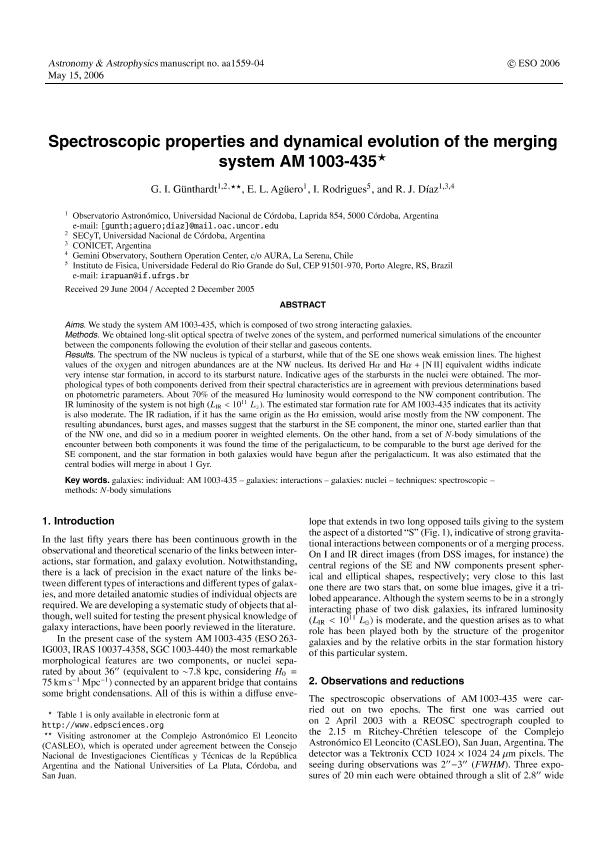Mostrar el registro sencillo del ítem
dc.contributor.author
Gunthardt, Guillermo Ivan

dc.contributor.author
Agüero, E. L.
dc.contributor.author
Rodrigues, I.
dc.contributor.author
Diaz, Ruben Joaquin

dc.date.available
2023-10-11T11:19:22Z
dc.date.issued
2006-12
dc.identifier.citation
Gunthardt, Guillermo Ivan; Agüero, E. L.; Rodrigues, I.; Diaz, Ruben Joaquin; Spectroscopic properties and dynamical evolution of the merging system AM 1003-435; EDP Sciences; Astronomy and Astrophysics; 453; 3; 12-2006; 801-808
dc.identifier.issn
0004-6361
dc.identifier.uri
http://hdl.handle.net/11336/214774
dc.description.abstract
Aims. We study the system AM 1003-435, which is composed of two strong interacting galaxies. Methods. We obtained long-slit optical spectra of twelve zones of the system, and performed numerical simulations of the encounter between the components following the evolution of their stellar and gaseous contents. Results. The spectrum of the NW nucleus is typical of a starburst, while that of the SE one shows weak emission lines. The highest values of the oxygen and nitrogen abundances are at the NW nucleus. Its derived Hα and Hα + [NII] equivalent widths indicate very intense star formation, in accord to its starburst nature. Indicative ages of the starbursts in the nuclei were obtained. The morphological types of both components derived from their spectral characteristics are in agreement with previous determinations based on photometric parameters. About 70% of the measured Hα luminosity would correspond to the NW component contribution. The IR luminosity of the system is not high (ZIR < 1011 L⊙). The estimated star formation rate for AM 1003-435 indicates that its activity is also moderate. The IR radiation, if it has the same origin as the Ha emission, would arise mostly from the NW component. The resulting abundances, burst ages, and masses suggest that the starburst in the SE component, the minor one, started earlier than that of the NW one, and did so in a medium poorer in weighted elements. On the other hand, from a set of N-body simulations of the encounter between both components it was found the time of the perigalacticum, to be comparable to the burst age derived for the SE component, and the star formation in both galaxies would have begun after the perigalacticum. It was also estimated that the central bodies will merge in about 1 Gyr.
dc.format
application/pdf
dc.language.iso
eng
dc.publisher
EDP Sciences

dc.rights
info:eu-repo/semantics/openAccess
dc.rights.uri
https://creativecommons.org/licenses/by-nc-sa/2.5/ar/
dc.subject
GALAXIES: INDIVIDUAL: AM 1003-435
dc.subject
GALAXIES: INTERACTIONS
dc.subject
GALAXIES: NUCLEI
dc.subject
METHODS: N-BODY SIMULATIONS
dc.subject
TECHNIQUES: SPECTROSCOPIC
dc.subject.classification
Astronomía

dc.subject.classification
Ciencias Físicas

dc.subject.classification
CIENCIAS NATURALES Y EXACTAS

dc.title
Spectroscopic properties and dynamical evolution of the merging system AM 1003-435
dc.type
info:eu-repo/semantics/article
dc.type
info:ar-repo/semantics/artículo
dc.type
info:eu-repo/semantics/publishedVersion
dc.date.updated
2023-07-07T20:29:42Z
dc.journal.volume
453
dc.journal.number
3
dc.journal.pagination
801-808
dc.journal.pais
Francia

dc.journal.ciudad
Paris
dc.description.fil
Fil: Gunthardt, Guillermo Ivan. Consejo Nacional de Investigaciones Científicas y Técnicas. Centro Científico Tecnológico Conicet - San Juan. Complejo Astronómico "El Leoncito". Universidad Nacional de Córdoba. Complejo Astronómico "El Leoncito". Universidad Nacional de la Plata. Complejo Astronómico "El Leoncito". Universidad Nacional de San Juan. Complejo Astronómico "El Leoncito"; Argentina. Universidad Nacional de Córdoba. Observatorio Astronómico de Córdoba; Argentina
dc.description.fil
Fil: Agüero, E. L.. Universidad Nacional de Córdoba. Observatorio Astronómico de Córdoba; Argentina
dc.description.fil
Fil: Rodrigues, I.. Universidade Federal do Rio Grande do Sul; Brasil
dc.description.fil
Fil: Diaz, Ruben Joaquin. Consejo Nacional de Investigaciones Científicas y Técnicas; Argentina. Gemini Observatorysouthern Operations Center; Chile. Universidad Nacional de Córdoba. Observatorio Astronómico de Córdoba; Argentina
dc.journal.title
Astronomy and Astrophysics

dc.relation.alternativeid
info:eu-repo/semantics/altIdentifier/doi/http://dx.doi.org/10.1051/0004-6361:20041559
dc.relation.alternativeid
info:eu-repo/semantics/altIdentifier/url/https://www.aanda.org/articles/aa/abs/2006/27/aa1559-04/aa1559-04.html
Archivos asociados
